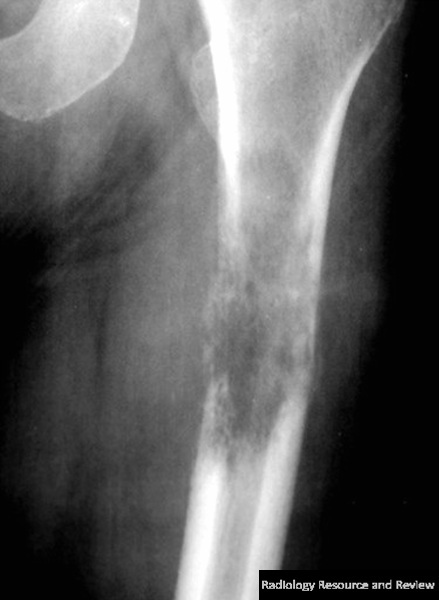|
|
Pathologic Fracture
General Considerations
- By definition, a fracture that occurs through bone which was previously abnormal
- Most frequent through a metastatic lesion or multiple myeloma
- May also involve enchondroma, unicameral bone cysts
- Suspect when there is an avulsion fracture in an unusual location, spontaneous avulsion of lesser trochanter in adult
- May occur in osteoblastic as well as osteolytic metastases
Clinical Findings
- Acute pain without antecedent trauma
- Soft tissue swelling or mass which may pre-date fracture
- Most common primary sites are breast, prostate and lung
Imaging Findings
- Fracture line extending through a destructive lesion in the bone
- Usually transverse in direction
- Surrounding bone may demonstrate
- Endosteal scalloping
- Cortical destruction
- Permeative pattern
- Frequently associated with a soft tissue mass
- Chondroid or osseous tumor matrix
- MRI
- Decreased T1 marrow signal in lesion
- Soft tissue mass and infiltration of the muscle
Differential Diagnosis
- On MRI, non-pathologic fracture-related hematoma
- Insufficiency fractures are seen with osteoporosis, not associated with a visible focal abnormality
- Fatigue fractures occur with repetitive stress in normal underlying bone
Treatment
- If the bone is weight-bearing, such as the femur, intramedullary rodding is frequently used
- Radiation if lesion is radiosensitive
- While radiation may help pain, it may also delay osseous healing
- Cement or bone graft may be used to fill a significant defect

Pathologic Fracture of Humerus. There is a permeative, lytic, and destructive lesion (black arrows) in the midshaft of the humerus with endosteal scalloping. There is a transverse pathologic fracture (white arrows) through the lesion.
For this same photo, click here

Pathologic Fracture of Femur. There is a permeative, lytic, and destructive lesion in the proximal femur with endosteal scalloping. There is a transverse pathologic fracture through the lesion.
For more information, click on the link if you see this icon 
Pathologic Fracture. E. David Weinberg, M.D. February 1931 Radiology, 16, 282-287.
StatDx
|
|
|